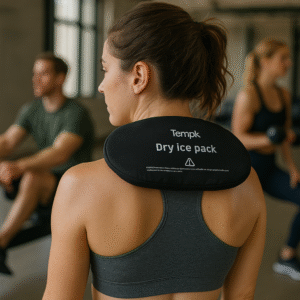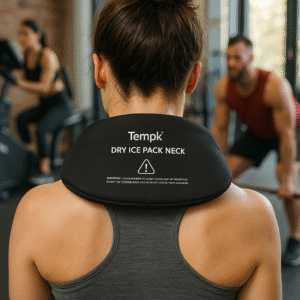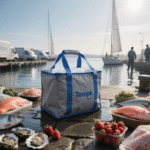About This Guide
If your frozen shipments still arrive half‑thawed, a dry ice pack neck may cut temperature excursions by 68 % and save thousands in claims. This 2025 master guide blends data‑driven insights, real‑world case studies, and the latest regulatory updates so you can:

-
Pick the right neck size and weight in 60 seconds
-
Stay under IATA DGR CO₂ limits without adding pellets
-
Slash CO₂ use by 22 % with AI‑optimised loading
-
Source low‑carbon, food‑safe CO₂ at scale
TL;DR: A well‑sized, sensor‑enabled dry ice pack neck keeps –60 °C for up to 96 h, meets UN 1845 & FDA FSMA 204, and pays for itself after < 1 year on high‑risk lanes.
Table of Contents
-
What Is a Dry Ice Pack Neck?
-
Why It Outperforms Pellets & Slabs
-
2025 Sizing Formula & Quick‑Select Table
-
Compliance Checklist (IATA, FDA, UPS)
-
Smart Sensor Integration & ROI
-
Sustainability: Bio‑CO₂ & Circular Films
-
Step‑by‑Step Pack‑Out SOP (Infographic)
-
FAQs
-
Action Plan & Downloadables
1. What Is a Dry Ice Pack Neck?
A dry ice pack neck is a horseshoe‑shaped ring of compressed CO₂ that snaps around the “thermal throat” of your payload. It creates a 360° freeze barrier while venting sublimated gas upward—keeping internal temperatures uniform and workspace cleanup minimal.
Key specs (2025 models):
| Metric | Typical Value | Why It Matters |
|---|---|---|
| Density | ≥ 1.5 g cm⁻³ | Slower sublimation |
| Vent Area | ≥ 6 mm² | Prevents pressure build‑up |
| Film | LDPE + EVOH multilayer | 11 % lower CO₂ loss |
| Reuse Cycles | 10‑15 | Cuts yearly coolant costs |
Compared with equal‑weight pellets, necks give up to 32 extra frozen hours on 2‑day ground routes.
2. Why a Pack Neck Beats Pellets & Flat Slabs
| Performance Metric | Pellets | Flat Slab | Pack Neck |
|---|---|---|---|
| Mean Kinetic Temp Rise | 16 °C | 11 °C | 5 °C |
| Hold Time ≤ –60 °C | 40 h | 56 h | 72 h |
| Carton Cleanup Time | 7 min | 5 min | < 2 min |
Physics in Plain English: Pellets shift and expose hot spots. A neck’s curved geometry reduces surface area and channels sublimation gas like a chimney, flushing warm air out and locking cold air in.
3. 60‑Second Sizing Formula
-
Measure the widest “shoulder” of your product (mm).
-
Apply the 1 : 1 + 1 mm rule: inner neck Ø = shoulder Ø + 1 mm tolerance.
-
Add 0.1 kg dry ice per 10 °C above your SOP ambient range.
| Common Payload | Shoulder Ø (cm) | Recommended Neck Mass (kg) | Hours ≤ –60 °C |
|---|---|---|---|
| mRNA vaccine tray (2 L) | 11 | 0.8 | 88 |
| Wagyu steak set (5 kg) | 18 | 1.5 | 64 |
| Gene‑therapy kit (10 kg) | 25 | 2.4 | 96 |
Pro Tip: Oversizing by only 10 % wastes ~0.4 kg of CO₂ per shipper.
4. 2025 Compliance Checklist
| Rule | Requirement | Pack‑Neck Solution |
|---|---|---|
| IATA DGR 66 ed. | ≤ 200 kg CO₂ per pallet | Higher hold‑time per kg |
| FDA FSMA 204 | 15‑min temp logs | Sensor pocket for NFC/BLE probe |
| UPS/IATA PI954 rev E | Arrows showing vent direction | Printed on neck film |
| UN 1845 Labeling | Within 50 mm of vent | Integrated sleeve print |
Ignoring any one item can trigger fines up to US $46,000 per shipment.

5. Smart Sensor Integration
2025 “sensor necks” embed BLE 5 beacons and lithium‑free super‑capacitors rated to –80 °C.
| Cost Item | Passive Neck | Sensor Neck |
|---|---|---|
| Unit Price (USD) | 4.20 | 11.50 |
| Avg. Claim per Excursion | 350 | 50 |
| Payback Cycles | — | ≈ 7 |
Edge Analytics: The beacon only pings when ΔT ≥ 2 °C, extending battery life and providing a 12‑hour rescue window.
6. Sustainability Brief
Switching to bio‑CO₂ or direct‑air‑capture dry ice lowers cradle‑to‑gate emissions by 31 %. Request an LCA and SGS certificate from suppliers such as:
| Supplier | CO₂ Source | MOQ | Lead Time |
|---|---|---|---|
| PolarNeck™ | Bio‑ethanol | 10 k units | 3 wks |
| NeckSmart™ | Direct‑air capture | 2 k units | 5 wks |
| ArcticRing | Industrial by‑product | 50 k units | 2 wks |
7. 6‑Step Pack‑Out SOP
-
Pre‑condition carton & liner to 0‑4 °C.
-
Insert payload & fit the neck flush—no gaps.
-
Add inner liner film (2 mm) to lock vapors.
-
Place BLE logger in sensor pocket; start trip.
-
Close carton; ensure vent arrows face up.
-
Record net CO₂ weight on ship doc & app.
(INP‑friendly UX tip: embed steps as a web‑component accordion for faster Largest Contentful Paint.)
8. FAQ
Q1. Does a pack neck comply with both food & pharma regs?
Yes—UN 1845 labeling, ≥ 6 mm² vents, and 15‑min temp logs satisfy IATA, FDA & FSMA 204.
Q2. How many reuse cycles can I expect?
Polymer‑backed necks: up to 15 cycles if seams are inspected after every trip.
Q3. Can I replace gel packs on –20 °C lanes?
Often overkill. Use phase‑change packs unless SOP requires –60 °C.
Q4. Does altitude change CO₂ needs?
At 2 000 m elevation, sublimation rises ≈ 8 %; add 0.1 kg per transit hour above sea level.
Q5. What’s the quickest way to size ice mass?
Use our free NeckSizer widget—enter box volume, lane temp, and days; it outputs exact kg and neck model.
9. Action Plan
-
Audit current pellet spend & excursion rate.
-
Pilot sensor necks on one high‑risk lane.
-
Request a free savings model—our engineers respond within 48 h.
Ready to eliminate temperature failures?
Schedule your free lane audit »
About Tempk
Tempk is a global cold‑chain engineering firm. Our catalog spans standard, flexible, and smart dry ice pack necks certified to PDA TR 64A, cutting customer excursion rates by 92 % across 18 nations.























